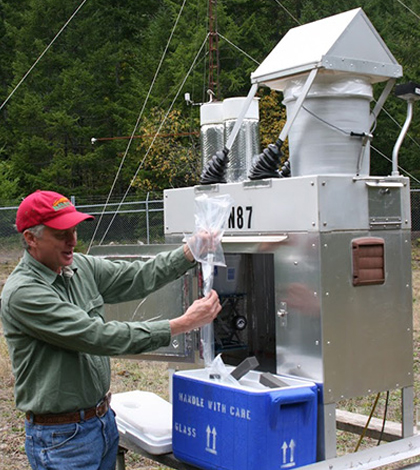Airborne North American Mercury Impacted By Asia

Monitoring sites like this one in Oregon maintained by the U.S. Forest Service collect precipitation samples which are then analyzed for mercury, sulfate, nitrate, and other pollutants. (Credit: Mark Brigham / U.S. Geological Survey)
Mercury pollution is a troubling thing, as the bioaccumulating, toxic metal can wind its way up food chains, impacting the health of wildlife and humans alike. And so it’s understandable that scientific studies continue to evaluate the pollutant in the water and in the air.
According to a recent investigation looking at mercury in the latter, that mostly falling through rain or snow, the long-term trends of airborne mercury are somewhat of a mixed bag in North America. The study, performed under lead authors from the University of California, Santa Cruz, relied on analyzing data collected at various monitoring sites around the country.
The network that provided the data has been collecting measurements since 1997, when monitoring sites were initially concentrated in eastern North America. Stations in other areas in the Midwest, Rocky Mountains and West Coast regions were added only relatively recently.
The long-term dataset extending back to 1997, which represents mostly the eastern regions, showed an overall decline in mercury concentrations. But when the researchers looked at more recent time periods starting in 2007 or 2008, they found many sites with significant positive trends in mercury concentrations.
That hadn’t been observed before, scientists say, and the sites with positive trends were primarily concentrated in the Intermountain West and in the central part of the country, including the Rocky Mountains, Plains, and Midwest regions. In contrast, areas along the Eastern Seaboard had trends that were still largely negative even for the shorter time periods.
Those findings are pretty consistent with other recent reports of decreasing atmospheric mercury deposition in North America since about 1997, but they add a twist. And by examining trends in more detailed time increments with more geographic insight, scientists were able to see that the long-term decreasing trend has leveled off in recent years.
Researchers add that some sites in the western part of the continent are seeing increases in mercury concentrations, which are likely due to increasing mercury emissions from Asia. That means that the reductions in North American mercury emissions are primarily benefiting the eastern U.S. where there is a greater concentration of emissions.
Specifically, mercury levels in rainfall have been trending steadily downward over the past 20 years along the East Coast. Those and other findings overall are consistent with increased emissions of mercury from coal-burning power plants in Asia and decreased emissions from those operating in North America.
In addition to mercury, the researchers also looked at trends in sulfate concentrations in rainfall, which is an indicator of local sources of emissions from coal combustion. While mercury and sulfate concentrations were closely correlated at East Coast monitoring sites, other sites showed a contrast between rising mercury concentrations and falling sulfate concentrations.
That finding indicates that mercury emissions in the U.S. and Canada are not the cause for the observed upward tendencies in mercury concentrations.
Mercury emissions have declined in North America and Europe for several reasons, including better emissions controls and increasing use of natural gas rather than coal as a fuel for power plants. The “scrubber” systems installed at coal-fired power plants in North America and Europe since the early 1990s to combat acid rain have also helped to reduce mercury emissions.
But emissions from Asia have been increasing and are transported over long distances in the upper atmosphere. The influence of the Sierra Nevada and Rocky Mountains on weather systems results in mercury from the upper atmosphere being deposited in precipitation in western states such as Nevada and Idaho and in the central United States, scientists believe.
The researchers also looked at trends for concentrations of gaseous mercury in the atmosphere, although less data are available than for mercury in rainfall. By merging several short-term datasets for air concentrations in North America, they found the trends were similar to the pattern for mercury in rainfall, meaning there was a downward trend for the early time period while a flatter slope emerged for the more recent period considered.
So even though a lot less mercury is being emitted into the atmosphere in the U.S. and Canada than there was 20 years ago, researchers say there are other factors at play. Emissions from other parts of the world, chiefly Asia, are very likely causing an increase in the amount of mercury that’s being deposited in certain parts of North America.
Top image: Monitoring sites like this one in Oregon maintained by the U.S. Forest Service collect precipitation samples which are then analyzed for mercury, sulfate, nitrate, and other pollutants. (Credit: Mark Brigham / U.S. Geological Survey)




0 comments